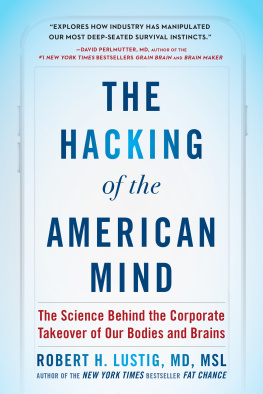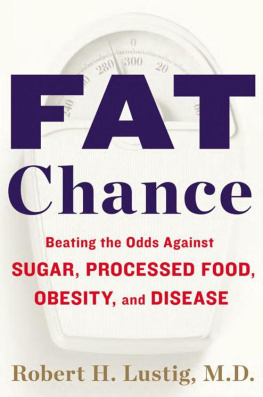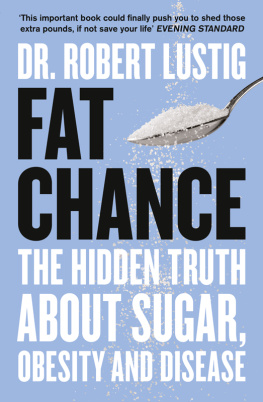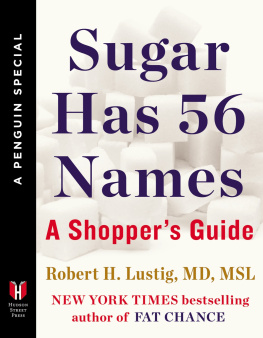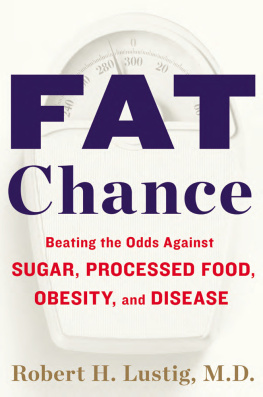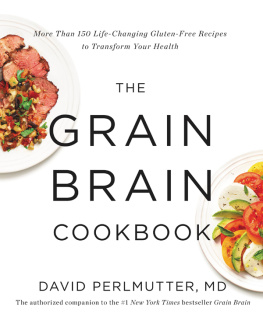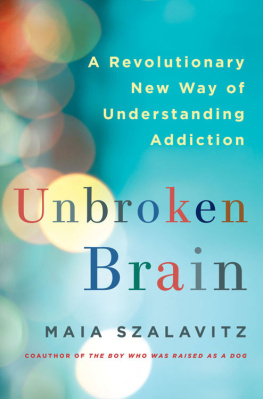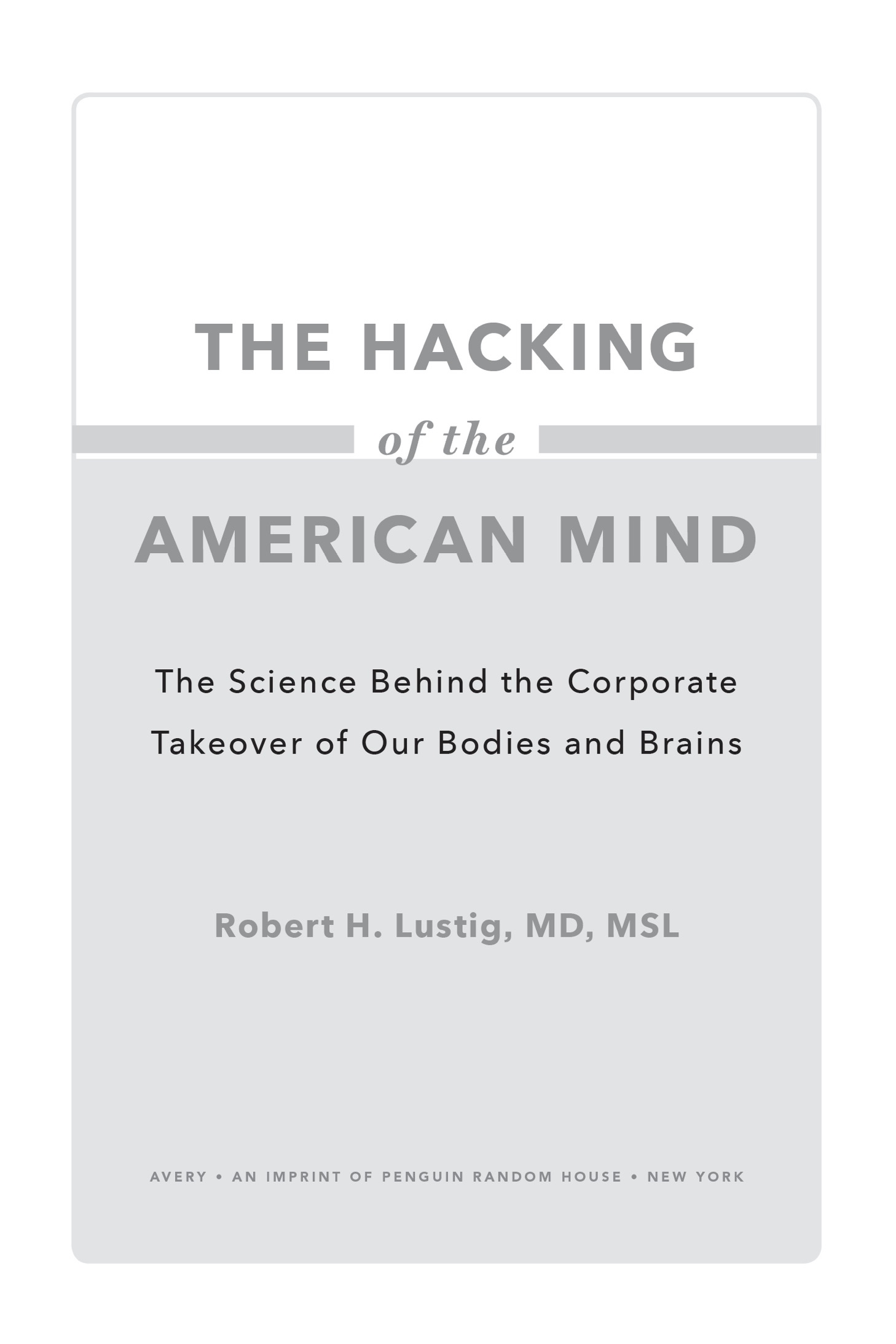
an imprint of Penguin Random House LLC
375 Hudson Street
New York, New York 10014

Copyright 2017 by Robert Lustig, MD, MSL
Illustrations copyright 2017 by Glenn Randle and Jeannie Choi, Randle Design
Penguin supports copyright. Copyright fuels creativity, encourages diverse voices, promotes free speech, and creates a vibrant culture. Thank you for buying an authorized edition of this book and for complying with copyright laws by not reproducing, scanning, or distributing any part of it in any form without permission. You are supporting writers and allowing Penguin to continue to publish books for every reader.
Library of Congress Cataloging-in-Publication Data
Names: Lustig, Robert H., author.
Title: The hacking of the American mind : the science behind the corporate takeover of our bodies and brains / Robert H. Lustig, M.D., M.S.L.
Description: New York : Avery, 2017. | Includes bibliographical references and index.
Identifiers: LCCN 2017031139| ISBN 9781101982587 (hardcover) | ISBN 9781101982594 (epub)
Subjects: LCSH: Happiness. | Pleasure. | Contentment. | Satisfaction.
Classification: LCC BF575.H27 L83 2017 | DDC 152.4/2dc23
LC record available at https://lccn.loc.gov/2017031139
While the author has made every effort to provide accurate Internet addresses and other contact information at the time of publication, neither the publisher nor the author assumes any responsibility for errors, or for changes that occur after publication. Further, the publisher does not have any control over and does not assume any responsibility for author or third-party websites or their content.
Version_1
Dedicated to my late mother, Judith Lustig Jenner (19342016), the inspiration for this book. My mother wasnt a particularly happy person. A Depression baby, she had to grow up quickly, and was an adult by the age of four. She missed out on a real childhood, and spent the rest of her life trying to make up for it. To her, money was the route to happiness, and she didnt want for it, but it never really made her happy. She certainly knew pleasuresin food and drink, in jewelry, in casinos, in exotic spots around the world. But few of her exploits or possessions brought her contentment. The only true happiness she knew were her children and grandchildren, and her eight-year relationship with her second husband, Myron Jenner, who was taken all too soon. Along the way and at the end, she also knew a large dose of pain and suffering as her body broke down from a debilitating neurological illness while her mind stayed as sharp as a tack. Rest in peace, Mom. I have no doubt that the happiness that eluded you in this world will be yours in the next.
CONTENTS
INTRODUCTION
Happiness is neither virtue nor pleasure nor this thing nor that, but simply growth. We are happy when we are growing.
J OHN B UTLER Y EATS TO HIS SON W ILLIAM B UTLER Y EATS , 1909
W e were all children once. Like you, more chance than not, my greatest moments of happiness during childhood have stuck with me, and to this day continue to bring a smile, and sometimes even a tear. Childhood is a time of mind expansionnot just in knowledge but in experimentation, in inquisitiveness, in trying out new concepts and strategies. Childhood is supposed to be a time when the balloon of happiness soars high above the mundane. The tools of the trade for most kids were a peanut butter sandwich, a bicycle, and a bedtime story. I became a pediatrician, in part, to relive and help channel the wonder and delight involved in growth.
Fast-forward four decades. Children still grow, but sadly in my pediatric clinic I now watch many of them grow horizontally rather than vertically. Some take medicines previously reserved for adults, like metformin for type 2 diabetes or benazepril for hypertension. And that balloon of happiness, that sheer wonder of it all, is now so deflated, there isnt enough buoyancy for it to soar. Rather, in its place has been dropped some weighty pleasures of the mundane, in this thing or that. Standard issue now are Capri Sun, Netflix, and Snapchat.
You might argue, well, thats progress, thats convenience, thats technology, thats our new instant gratification culturebuy a pleasure to increase happiness. But what if those pleasures, ostensibly developed and marketed in the name of increasing your happiness, actually did the opposite? What if they actually made you unhappy? What if they changed your brain so that happiness was sapped from you? What if todays kids are actually canaries in the coal mine? What if these same brain changes extended to your coworkers, to your friends, to your family members, and to you? For better or worse? And better for whom?
Pleasure and happiness are similar, as they both feel good. But Yeats knew they werent the same. Since the recording of time, philosophers have tried to wrestle these two positive emotions to ground. These two uniquely human phenomena have together and separately occupied outsized parcels of our consciousness, our literature, and our national and international discourse. While our philosophers and social commentators have spent the last three thousand years defining and redefining these two terms for us, something quite unusual and likely even sinister has befallen these related yet decidedly different positive emotions.
These past forty years have witnessed the twin epidemics of the negative extremes of both of these emotions: addiction (from too much pleasure) and depression (from not enough happiness). Yet in these same forty years our knowledge of brain science has advanced to the point where these two emotions can now be dissected and parsed at a biochemical level. Did the uptick in prevalence of addiction and depression occur naturally? Separately? In a vacuum? Or under some form of outside pressure? What, or who, has ushered modern society into this new normal? What if all of Western society has been hacked, to profit a few at the expense of the many? And what if you didnt even know youd been hacked?
Hack is a word with a relatively short history in our modern lexicon, with a fluid meaning. The first reference to a hack was at a meeting of the MIT (my alma mater) Model Railroad Club in 1955. At that time hack meant a prank whose perpetrators demonstrated style, resourcefulness, and whimsy in its performance. Stealing a car is a felony offense. Stealing a Boston Police Department vehicle, disassembling it, carrying each piece up five floors, and then reassembling it at the top of the Great Dome at MIT, complete with a life-size policeman mannequin and a box of doughnuts in the front seatnow that is a hack. More recently Silicon Valley types stole the word to denote clever solutions to difficult problems, known as white hat hacking. Yet black hat hacking dates back to 1963, when an unauthorized hacker remotely commandeered the MIT mainframe computer. As computers became more interconnected and more technologically advanced, less whimsical people started to create viruses to infect other computers, and hacking took on a much more ominous and sinister tone. As we all learned from the 2016 election debacle, todays computer hacking encompasses three steps. Step one is pfishing, where a seemingly benign yet imperative e-mail message with a disguised zipfile or URL is sent to an unsuspecting victim; if the message is clicked, that computer is rendered vulnerable and the hacker can gain entry. Step two is the insertion of some form of malicious code into the victims computer. Depending on the goals of the hacker, step three is the hijacking of somethingfor instance, the material stored in a computers memory (like Democratic National Committee e-mails), which is transferred to the hacker, who can use it to humiliate or blackmail; or the computers executable files, in order to hold the computer for ransom; or even the victims hard drive, which can be crashed and erased, the ultimate in malevolence.

